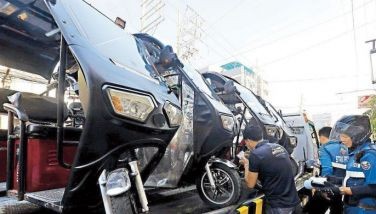#Journeyto30 The judge becomes the judged
MANILA, Philippines – The Corona family watched as the final day of the impeachment trial of their patriarch, former Supreme Court chief justice Renato Corona, unfolded on television. They had been in a private room of the Medical City in Pasig for about a week, where Corona had been recuperating after being rushed there after taking the witness stand.
Corona calmly watched as each senator explained his or her vote. After all of them had finished casting and explaining their votes, the tally showed an overwhelming guilty verdict – 20 senators versus three who voted not guilty.
That conviction was four years ago today. And yet, it remains vivid and clear in our memories, especially with the recent death of the former chief justice.
Many of us can still remember how glued we were to our TV sets after lunch just to watch the trial unfold. For a time, it became our alternative to afternoon teleseryes, as the trial was as melodramatic as the soaps it temporarily displaced. And, being the first impeachment trial covered on the Internet, it became the subject of netizen discussions, even ridicule in social media.
Corona’s fate was somewhat sealed the moment former president Gloria Macapagal-Arroyo appointed him as chief justice on May 17, 2010 – one of the 200 midnight appointments that Arroyo made just a week after the presidential elections, which incumbent President Aquino won.
In protest of his appointment, President Aquino refused to have Corona administer his oath of office and instead chose Supreme Court Associate Justice Conchita Carpio-Morales for that task.
As expected, the Supreme Court under Corona created huge headaches for Aquino. On July 26, 2011, it declared unconstitutional Aquino’s Executive Order No. 1 that called for the creation of a Truth Commission to investigate allegations of graft and corruption during the Arroyo Administration. When Justice Secretary Leila de Lima issued a hold departure order against the Arroyo couple on Oct. 28 to prevent them from leaving to supposedly seek medical treatment for the former president abroad, the SC issued a conditional temporary restraining order (TRO) against De Lima’s order. The secretary, nevertheless, ignored the TRO and ordered the couple’s arrest on their way to the airport.
But the biggest bone of contention that Corona’s SC threw at Aquino was its Nov. 22, 2011 decision ordering the distribution of 5,000 hectares of Hacienda Luisita, the prime sugar estate in Tarlac owned by the Cojuangco clan. According to the court, the stock distribution option implemented by Hacienda Luisita Inc. was not in line with the Comprehensive Agrarian Reform Program (CARP).
Incensed at the apparent defiance Corona’s SC has shown, Aquino found his voice and began lashing out against the chief justice. On Dec. 1, 2011, the President questioned the SC’s decisions at a speech delivered to the Makati Business Club. Four days later, he publicly lambasted Corona, who was present at the First Criminal Justice Summit.
In an effort to appease the President’s wrath, the House of Representatives moved to impeach Corona. On Dec. 12, 2011, 188 House members signed the eight Articles of Impeachment, based on allegations of graft and corruption, culpable violation of the Constitution and betrayal of public trust. With two-thirds of the House having signed, the Articles of Impeachment were immediately sent to the Senate. On Jan. 16, 2012, the Corona impeachment trial began.
Of the eight Articles of Impeachment, the trial mostly centered on the second article, wherein Corona allegedly betrayed public trust and violated the Constitution by not disclosing the entirety of his wealth in his Statement of Assets, Liabilities and Net Worth (SALN) from 2002 to 2010.
Among the wealth that Corona did not declare included real estate properties in Taguig, Makati and Quezon City, as well as bank accounts in Philippine Savings Bank and Bank of the Philippine Islands. It was Corona’s non-disclosure of these properties and finances that ultimately convinced 20 senators to convict and impeach him on May 29, 2012.
While there have been allegations that the Aquino administration resorted to bribery by giving P50 million in discretionary funds as incentive to legislators who impeached Corona, these allegations weren’t proven to have affected the outcome of the case.
Corona died last April 29, a month ago today. While he spent the latter part of his life as an esteemed jurist caught in a battle between two administrations that resulted in the discovery of skeletons in his own cabinet, he lived that part of his life believing that he had upheld the Constitution and protected every Filipino who had less under the law.
His blatant faults, judicial defiance and philosophy of law will become lessons, not just to every Law student, but also to every public servant in the coming years.
- Latest
- Trending


























